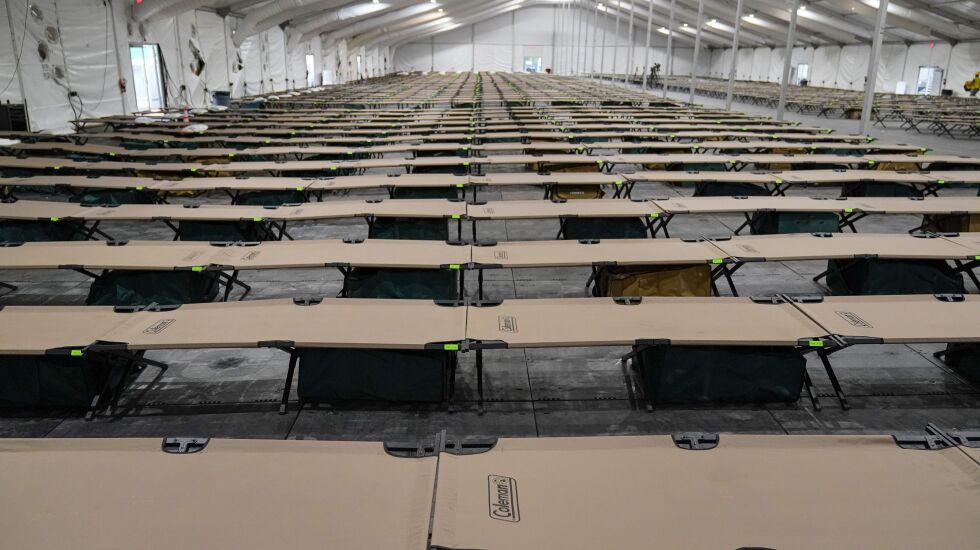
Nearly 1,600 asylum seekers would be moved out of Chicago police stations “before the weather begins to shift and change” and into “winterized base camps” with massive tents, under a plan unveiled Thursday by Mayor Brandon Johnson.
Johnson refused to say where the tent cities would be built, only that the city has identified suitable locations across the city. The tent structures he envisions could hold up to 1,000 migrants, though 500 or so was an “ideal scenario.”
During an abbreviated interview with the Sun-Times, the mayor offered no specifics on cost or funding as he described the broad outlines of a plan that includes “base camps” that would have meals as well as recreational and educational programming provided by Chicagoans as a way to reduce what he called the “exorbitant” costs now being paid to a private staffing agency.
Without offering specifics, the mayor also described a “comprehensive and coordinated safety plan at every single shelter” — including the 16-and-counting created by the city to house the 13,500 migrants already here, with more busloads arriving every day.
He further promised an “additional agency to expedite resettlement” while continuing to “partner with the state and county to create more welcoming spaces to take the burden off” Chicago.
Pressed repeatedly, Johnson did not rule out budget cuts or tax increases or both to pay for a burgeoning humanitarian crisis already costing Chicago upwards of $30 million-per-month.
But he acknowledged “sacrifices” will be required of the city he now leads and said the cost of not making those sacrifices would be far greater.
“These families are coming to the city of Chicago. … If we do not create an infrastructure where we’re able to support and, quite frankly, contain these individuals who have experienced a great deal of harm, individuals who are desperate — if we do not provide support for these individuals and these families, that type of desperation will lead to chaos,” Johnson said.
“There is a sacrifice that is going to be required in this moment. … The sacrifices that we are prepared to make in order to ensure that this city is not chaotic and it is not riddled with desperate people… And I’m confident that we can do both. That we can make sure that we invest in people who have been marginalized in this city under previous administrations while also staying true to our values.”
Earlier this week, several migrants were arrested in separate incidents on suspicion of threatening or battering officers at the 12th District police station.
City Council members have also decried what they described as “lawlessness,” including drinking, sex trafficking, drug dealing, narcotics use and gang recruitment,” outside Chicago’s migrant shelters.
“I’m glad you raised that,” he told the Sun-Times. “You’re making my point. … Anything absent the type of investments that I am prepared to make and the sacrifices that I am gonna ask the city of Chicago to stand alongside me — anything short of that is going to cause and create that much more damage and chaos,” he told the Sun-Times.
Senior mayoral adviser Jason Lee was even more pointed in his warning about the risks to Chicagoans absent bold solutions.
“This population is very vulnerable. They don’t necessarily speak the language. They don’t know all the ins-and-outs and they can be subject to exploitation. They can be recruited into criminal enterprise,” Lee said.
“They can be doing whatever they have to do to survive, which would be understandable, but also could lead to significant consequences for the people of the city.”
Two weeks after taking office, Johnson persuaded a divided City Council to slap a $51 million Band-Aid on Chicago’s burgeoning migrant crisis after a cathartic and racially-charged debate that reduced one member to tears. The 34-to-13 vote provided only enough funding to carry Chicago through June 30.
Since then, the parade of buses has increased exponentially. The faster the city opens shelters, the quicker they fill up. The more space the city needs to find.
A top mayoral aide warned last month that Chicago could experience a fivefold increase in arriving migrants — up to 10 busloads a day — sent here by Republican governors trying to embarrass and strain Democratic sanctuary cities in the run-up to the 2024 Democratic national convention.
The mayor wholeheartedly agreed — but strongly disagreed with his New York City counterpart Eric Adams, who warned this week that the 110,000 asylum seekers who have descended on that city at a cost of $1.5 billion and counting would “destroy New York City. … The city we knew, we’re about to lose.”
“I’m not going to accept the notion that the city of Chicago is going to be destroyed,” Johnson said.
“We are a city of big shoulders. We’ve been through difficult moments and challenges before. And we’re gonna get to the other side of this. I’m confident of that. … I was elected to lead. This is not a challenge that will overwhelm us.”

The mayor’s promise to get migrants out of Chicago police stations before the weather turns was music to the ears of Fraternal Order of Police President John Catanzara. He could not care less whether asylum seekers are moved to tent encampments or somewhere else so long as police officers are no longer “babysitting” them.
“The longer you have a situation like that, you’re going to have personalities and tempers flaring with the migrants themselves. And the police are gonna be called in to deal with them, unfortunately,” Catanzara said.
“Coppers are beyond fed up with it all. The desk in the station used to be a spot where officers would ... take a break, come in off the street and just kind of socially interact with other officers. [But] nobody wants to be in a station longer than they have to at this point. The smells. ... It’s a bio-hazard. It’s an overcrowding situation. I don’t know why the Department of Buildings, the Fire Department — nobody is insisting on doing anything about it. Apparently, they have their marching orders to let it go.”
Ald. Andre Vasquez (40th), who chairs the City Council Committee on Immigrant and Refugee Rights, applauded the mayor for his creativity. But Vasquez was deeply concerned about expecting tents to get through what could be a “very harsh” Chicago winter.
“We understand that police stations are not a place for anybody to live or sleep in. But tents? I have to see more detail to know if that’s a better solution. ... It’s Chicago winter. Having people out there in a tent is a concern for anyone,” Vasquez said.
“It shows how challenging things are when we’re not having enough support from the state and federal government. If we don’t have work authorizations moving forward and more funding to actually acquire or rent property, you end up with tents in the middle of a Chicago winter, which I don’t think anyone wants to see.”
Ald. Mike Rodriguez (22nd) also thought it was a good idea to move migrants from police stations, even if it is into tents — for now.
“I cannot support 3-year-old children sleeping on police station floors. This situation is untenable. I think the mayor would agree and state that this [tent concept] is not ideal. But, if there’s a dignified way to house them temporarily [somewhere else], I’m supportive of that.”
Johnson refused to say how many tent cities he envisioned. But every one of them will be big.
“What has been proven to be most effective — particularly cost effective — are locations that house and shelter more people. Particularly places in locations that house 500 or more individuals. Those are the ideal scenarios,” he said.
“These base camps can get up to 1,000. They have the ability and capacity in a secure way to hold as many as necessary. And we’ve identified multiple locations throughout the city of Chicago. We’re prepared to provide as much support as needed.”







